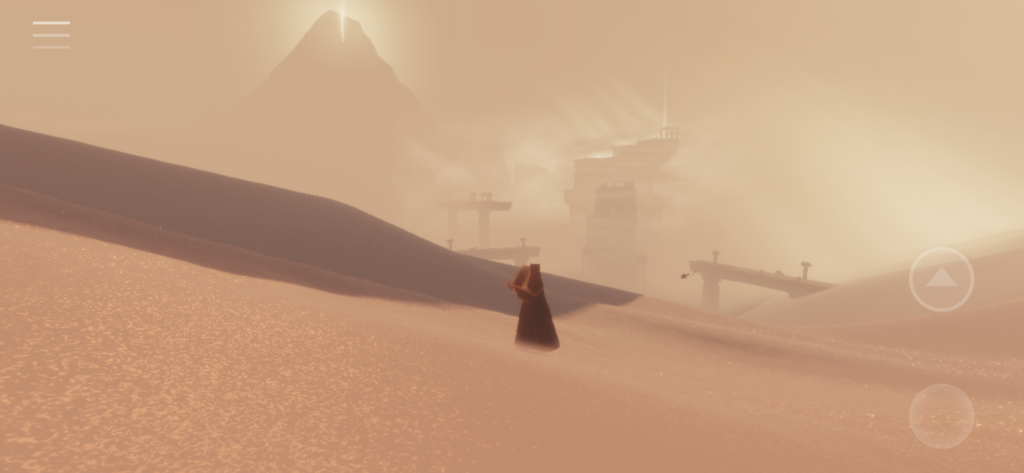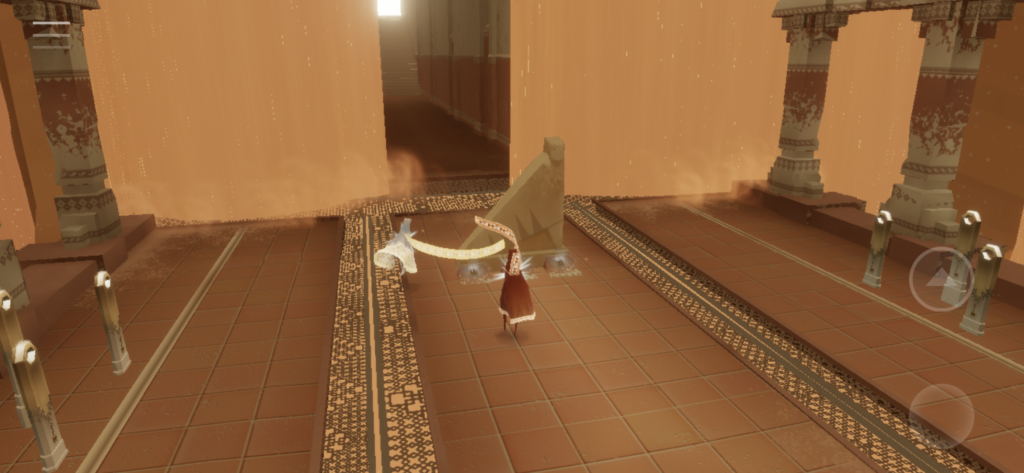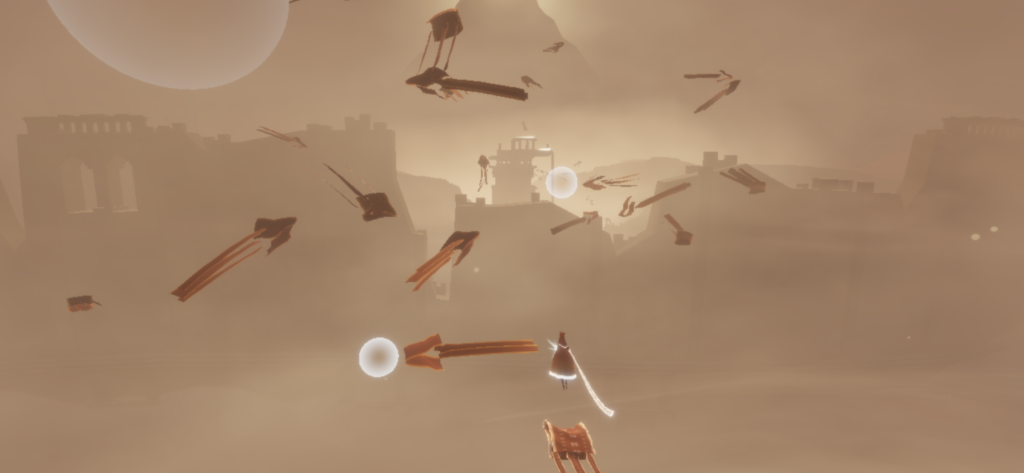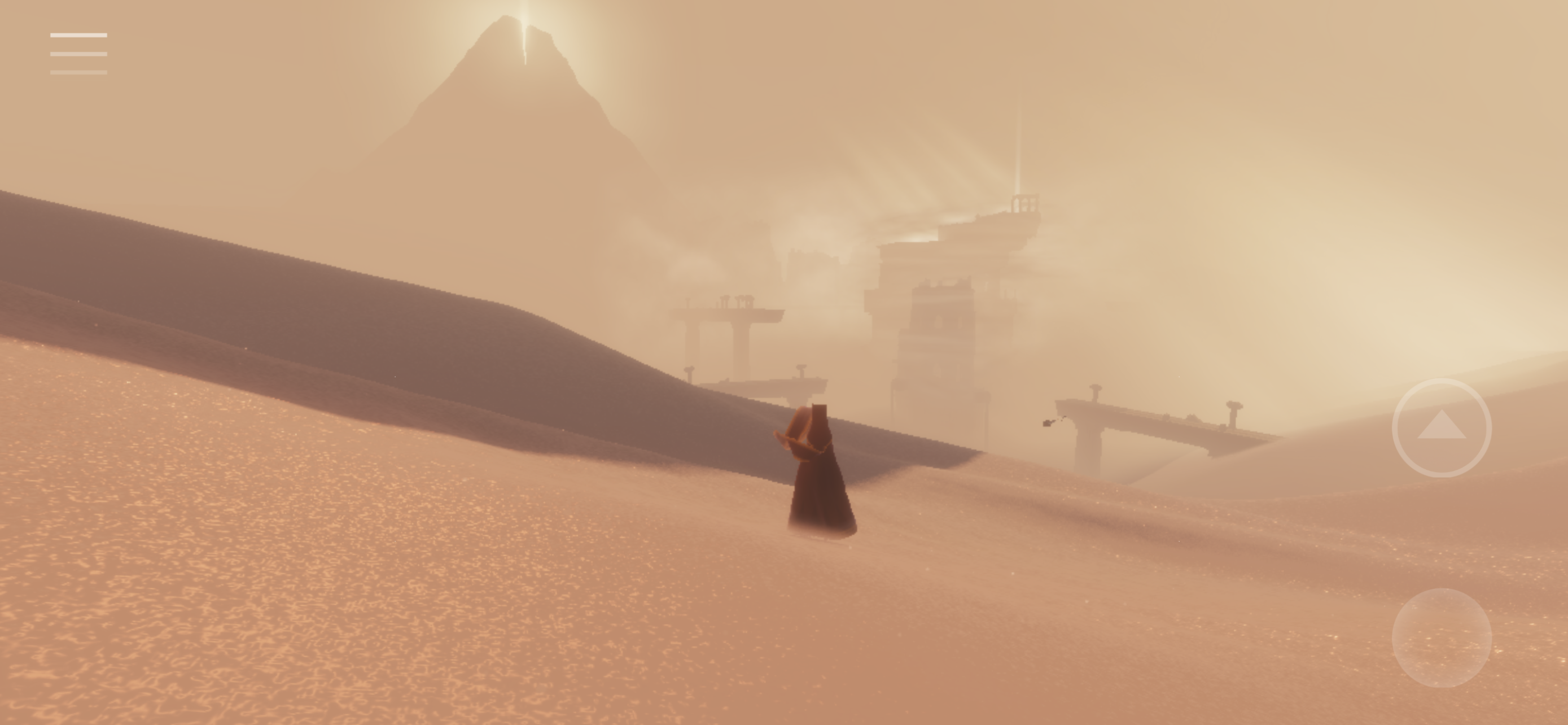Name of game: Journey
Creator: thatgamecompany and Santa Monica Studio
Platform: I played the game on iOS. The game is originally released on PlayStation.
Target audience: people who enjoy art games, or games with a cinematic or strong emotional experience. Because the game has a low physical skill (e.g. hand-eye coordination) requirement, casual gamers would also be in the target audience.
Important formal elements of the game:
Players: single player most of the time. Player is sometimes randomly connected to another player also going through the same part of the journey, but there is minimal interaction. This adds to the feelings that the game wants to evoke: loneliness, being overwhelmed by nature, and the small sparks of human connection.
Objective: to complete all the ‘levels’. Levels are divided by cinematic cut-scenes, which gave me a sense of progress when a lot of the game is walking around.
Rules / Procedures: Player traverse the desert and collect symbols, which activate glyphs that allow players to continue to the next level. Movement is limited to walking, flying when character’s scarf is ‘charged’. Character can also sing / shout, which I have not discovered to have an in-game function except to communicate with other players. The limited range of movements makes the player focuses on the story and the setting of the game, which in turn helps the game achieved its aesthetic goals (see Type of Fun section).
Boundaries: very open-world, but there are always guides / landmarks that lead player to the next important structure (often the location of a symbol). This makes for a gentle difficulty cure that allows players to focus on the narrative and the world.
Type of fun game intended, and if it met its goals:
Journey intends to provide Narrative and Discovery fun. For Narrative, it has an embedded narrative structure that unfolds as the player walks through the desert. I thought it was interesting that unlike other embedded narrative games, where the ‘goal’ of the game is to uncover the embedded narrative (Dear Esther, for example), the most obvious ‘goal’ in Journey is not to explicitly find out what happened to the world. Instead, as I walk around the world and solve puzzles to collect symbols, the texture of the world gives little hints to the story. (For example, why are the red ‘kites’ — established early on in the game to be friendly — trapped in a tower?) The space design carefully considered lock and keys, with landmarks being ‘locked’ if players have not achieved something previously. There are often hints for players to follow the ‘narrative arc’ (for example, a musical call, or the flying kites — see screenshot below). The puzzles itself are never too difficult, only consisting of physically moving through the world (rather than solving riddles, for example). This gentle curve of difficulty adds to Narrative fun because players are able to continue following the story at the pace that the game designers had wanted the story to unfold.
 (Hints in game: next to the bridge jutting out from the right is a ‘kite’ that had been leading me to this location)
(Hints in game: next to the bridge jutting out from the right is a ‘kite’ that had been leading me to this location)
The game also provides a lot of Discovery fun in how rich and beautiful the world is. Every structure in the game is beautifully-designed. Part of the Discovery fun for me was discovering how my character moves through the world — the physics of flying, walking, falling, sliding down sand dunes was fascinating to watch.
Some moments of particular success include:
- It was extremely delightful to come across other players. The image of the two identical characters, small figures in the middle of a vast desert, was very powerful and evokes a feeling of companionship and connection. We could not interact with each other except through the ‘singing’ gesture, but I thought that made the feeling of connection even more powerful. This also serves as a friendly help system that is integrated within gameplay (the player I connected with showed me how to solve a puzzle in the game), which I thought was really smart.
 (This was the first other player I met — character in white robe. Even though we could not communicate, we ‘sang’ at each other, and we traveled together for a bit.)
(This was the first other player I met — character in white robe. Even though we could not communicate, we ‘sang’ at each other, and we traveled together for a bit.)
- Very early on in the game, realizing that I can fly (in addition to the walking movement). Similar to that, realizing that I can ‘ride’ on a kite (see screenshot below) and walk up a flying tapestry. Or fall without dying! The range of movements the character is allowed to do (and the beautiful physics of these movements) really draws me into the game. This gives me the idea that the story of a walking sim can also be the story of the player-character (in Journey’s case, the story of the character discovering these abilities).
 (Player can ‘ride’ on the kites for a short time. The surprising interaction with other objects in the game world brings a lot of Discovery fun.)
(Player can ‘ride’ on the kites for a short time. The surprising interaction with other objects in the game world brings a lot of Discovery fun.)
Things you would change to make the game better:
Some of the puzzles require dexterity (for e.g., your character is only able to fly for a short amount of time, and you need to fly in the correct direction for all that time in order to reach the goal. If not, you will fall down and have to restart). For a game that is focused on Narrative and Discovery fun, I would reduce the dexterity requirement and make those puzzles easier to make the game more inclusive for people of diverse physical abilities.



